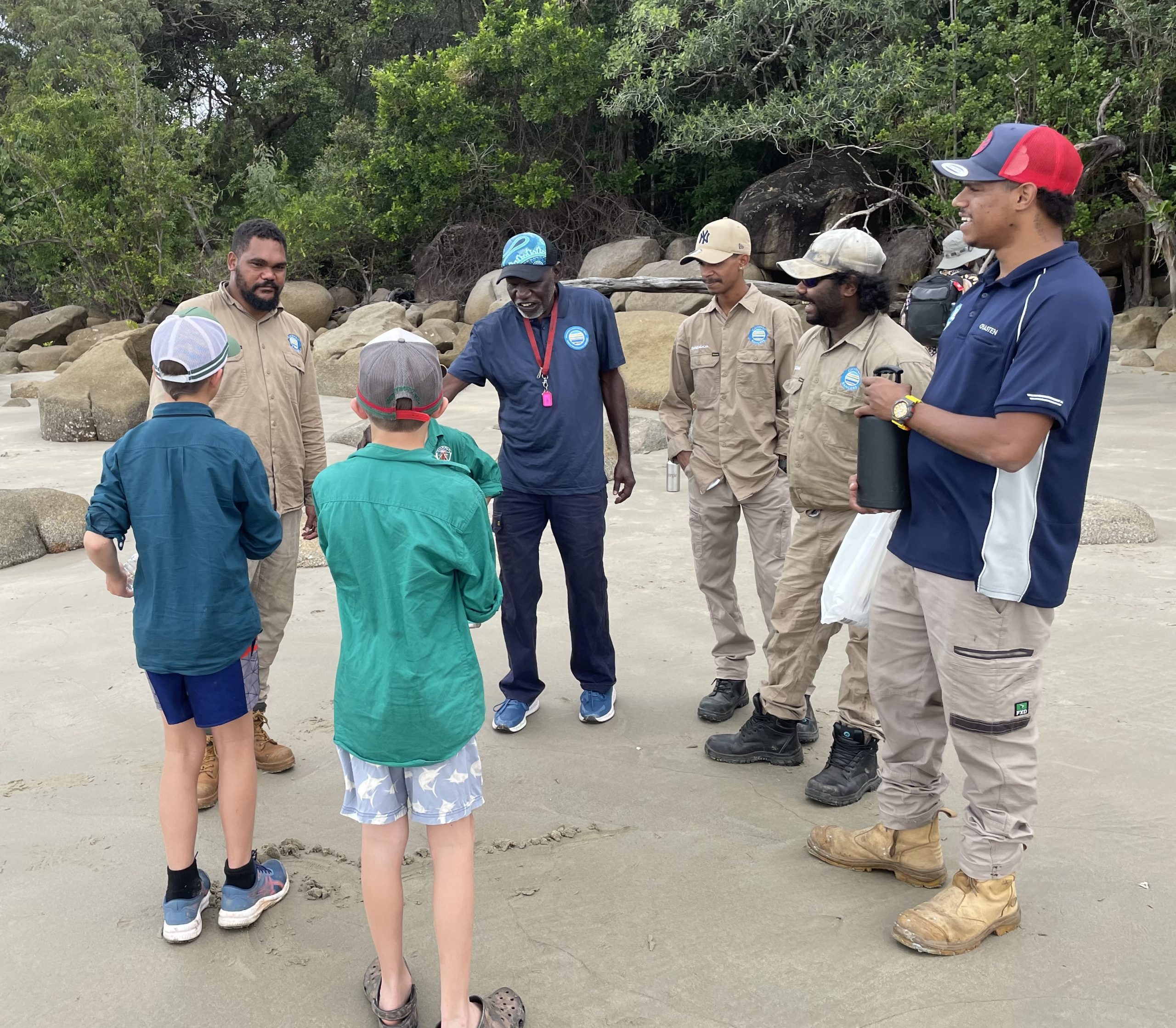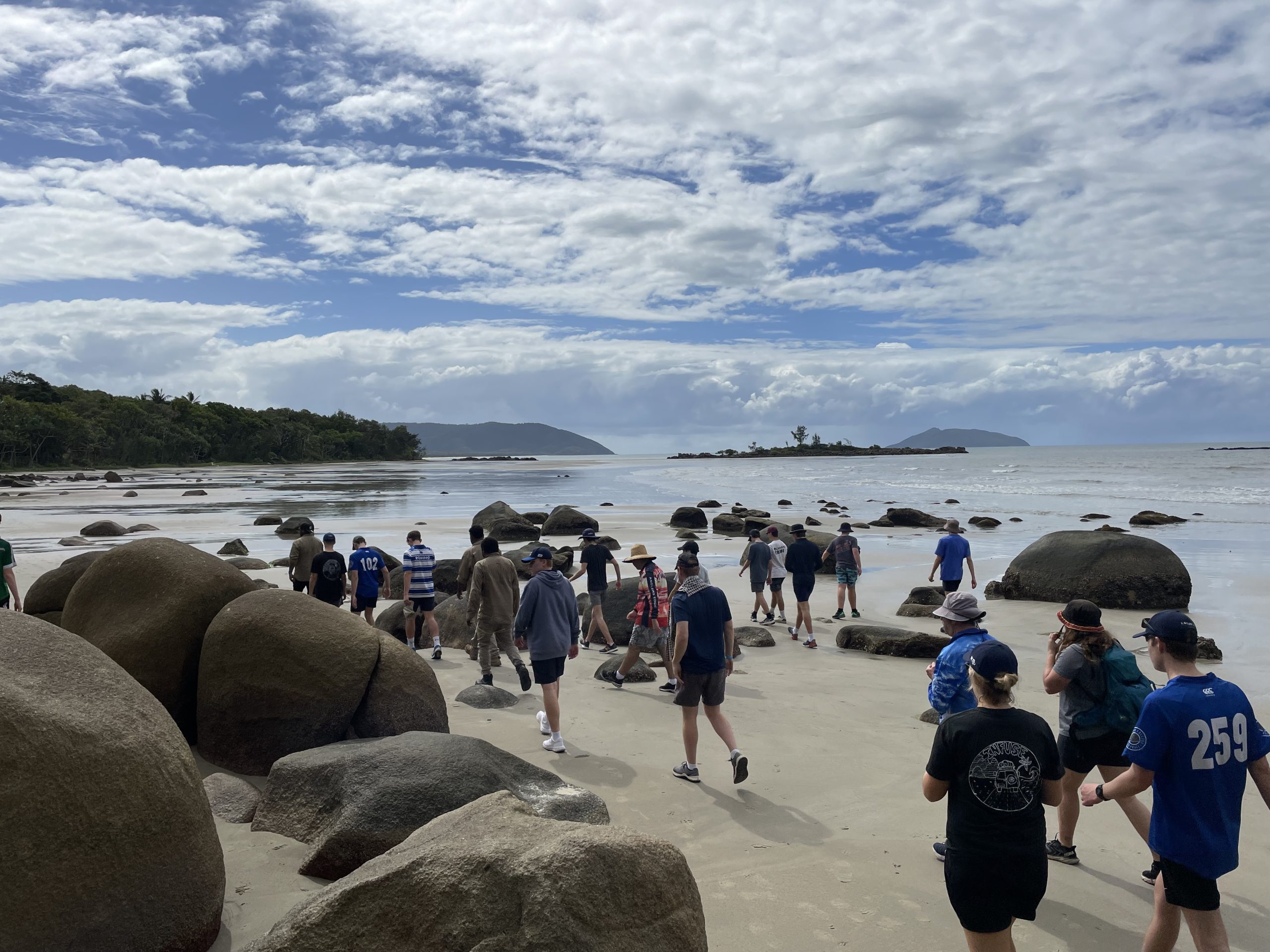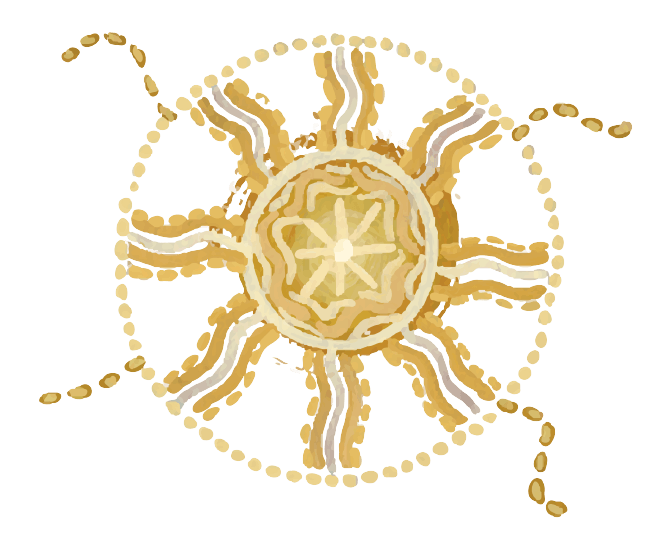
Far North Queensland is blessed with two UNESCO World Heritage areas — The Wet Tropics (of which the Daintree Rainforest is a part) and The Great Barrier Reef–both of which contain some of the planet’s best biodiversity. Led by knowledgeable guides, your trip explores the wonders of these World-Heritage sites that hosts some of the planet’s best biodiversity.
On this trip, experience first-hand the impacts of both natural and human activity on these two ecosystems. Learn while on country from Indigenous rangers how they are managing country; discover endemic and endangered species, perform field techniques, and collect data through citizen science projects. You also investigate current management strategies for tackling invasive species and other threats to both precious ecosystems.
“5 stars. Good communication and nothing was too much trouble. It was explicitly tailored to the educational needs of our students…as opposed to being just focused on tourist activities.”
–Charles Rushworth, teacher, Cowra High School NSW (May 2025)
for 15 or more students
for 10-14 students
Details
- Snorkel the Great Barrier Reef with a marine biologist
- Soar high into the Daintree rainforest in JCU’s canopy crane
- Participate in CoralWatch service project and collect primary data on coral bleaching
- Discuss traditional land uses with Indigenous guides on country
- Collect primary data about water quality and aqautic invertebrates at a university rainforest research station
- Learn about traditional and contemporary protected area management
- Visit a Turtle Rehabilitation Centre run by volunteers
- Risk assessment
- Cairns airport transfers
- All activities as described in the itinerary
- Transportation to activities
- Small World Journeys land guide on Days 1, 2 and 5
- Marine naturalist/marine biologist on Days 3 & 4
- Expert speakers and Indigenous guides
- 4 nights Cairns 3-star hotel accommodation (2 or 3 share ensuite rooms)*
- 1 night Daintree Rainforest research station (single gender dorm-style rooms)
- All continental breakfasts
- All lunches
- All dinners (except on Day 4)
- Mask, fins, snorkel hire on Fitzroy Island and outer reef trip
- Stinger suit hire during the wet season
- 101 Marine Animals of the Great Barrier Reef and 101 Marine Animals of the Wet Tropics field guide for each student
- Care for A Coral donation through Reef Restoration Foundation
- Small World Journeys BPA free reusable water bottle and cloth shopping bag
- National Park and Marine Park taxes and levies
- NEW: we offset the carbon emissions from your trip activities AND your flight to Cairns!
*Cairns accommodation – Two teacher rooms (private twin or triple share rooms) are included in the trip price for groups of 15 students or more. For trips with low numbers (10-14), one teacher room is included. A supplement is charged if an additional private room is required for the trip (please ask us for pricing). If teachers are happy to share a room, no additional costs are incurred. Single supplement is not available at the Daintree Rainforest Research Station, teachers and guides may be required to share dorms here.
Small World Journeys reserves the right to change the order of activities for logistical reasons.
Prices are valid for travel 1 April 2026 until 31 March, 2027 outside of peak travel times.
(If you wish to travel before 1 April 2026, ask us about 2025-26 pricing)
Peak travel times: 1-7 April 2026 | 21 June – 13 July 2026
- Airfare to Cairns
- 1 Dinner – free choice in town
- Personal expenses (souvenirs, laundry, etc.)
Planning Your Trip
ACCESSIBILITY MENU: Small World Journeys’ website provides an accessibility menu. Visitors to our website can click on the “person” icon on the right side of the screen to bring up this menu. Options include increasing/decreasing font size, increasing/decreasing contrast, dyslexia-friendly fonts, and the ability to hide images, among other things.
BOOKING FORM: On our online booking form, we ask all participants to list any special needs they have, be them medical, dietary, or accessibility needs. We also offer free sensory packs to our guests who are neurodivergent, which include headphones, a timer for transitions, a squeezy fidget toy, and other treats to appeal to the senses like flavoured lip balm.
WAIVER FORMS: We understand that not all of our participants’ parents have a strong command of written English and therefore understanding and signing our on-line waiver may prove challenging. We therefore have our wavier form available in the following languages on request: Chinese, French, German, Italian, Japanese, Portuguese and Spanish.
Arrival at Cairns Airport
ACCESSIBLE TOILETS: Public toilets are located throughout the terminals. Each toilet facility includes an accessible toilet suitable for wheelchair access.
TGSI and HEARING LOOPS: The Cairns Airport makes use of Tactile Ground Service Indicators (TGSI) and Hearing Loops to assist people with vision impairments and hearing difficulties, respectively. For example, Braille is included on toilet doors/signs to assist a person with vision impairment locate the correct facility.
ASSISTANCE FOR HIDDEN DISABILITIES: If you or someone you are travelling with has a hidden disability, you can request a hidden disability lanyard through a form here. Wearing a sunflower lanyard when you are at Cairns Airport is a discreet way for you to indicate to the airport team that you may need a little extra help, guidance or time with the airport processes. The airport team has been trained to recognise the lanyard and provide the assistance and support you may need. Some of the airport staff will also be wearing a Sunflower badge on their shirts or lanyards to help you feel a little more at ease.
VISUAL AND WRITTEN STORY GUIDES: Visual Story Guides are available for Domestic Arrivals and have been designed to help you to understand how an airport works and what to expect. Written Story Guides are also available for Domestic Arrivals.
Our Safety Talks
Our arrival safety talk is done verbally but is supported by cards that illustrate the main talking points. Similarly, our snorkelling safety talk is done in the same manner, supported by cards with pictures and illustrations.
We can provide a transcript of our safety talk to any hearing-impaired guest.
Transport
Our buses have two steps up of approximately 40 cms to get inside. There is no lift for a wheelchair or mobility device. Similarly, on occasion we hire large coaches for bigger groups and those buses also have two steps up of about 40 cms to get inside. All buses are equipped with seatbelts.
Presentations & Workshops
OUR OFFICE & PRESENTATION SPACE: We use the Small World Journeys office space for presentations, workshops and some community service projects. There is a rise of approximately 2 cm to enter the presentation room. We have one accessible, gender-neutral toilet block with shower.
In the outside area of our office, planes fly overhead frequently and the noise can be startling and confronting. However, as part of the terms of construction, the entire building has sound mitigation devices (double glazed windows, etc.) which creates the opportunity for multiple breakout spaces for neuro-divergent people who desire a quiet space with reduced stimuli.
Our presentations are designed to appeal to both visual and auditory learners. We can provide a transcript of our presentations to any hearing-impaired guest.
NOVOTEL PRESENTATION SPACE: We also use Novotel Cairns Oasis Resort for presentations at dinnertime.
Overall accessible resort information:
- All entries to the hotel are wheelchair-accessible
- 2 accessible spaces in the on-site car park, near lifts
- 1 accessible toilet in hotel lobby (hand rail | grab bar)
- Most walkways within the hotel are wheelchair-accessible
- Well-lit main areas
- All meeting rooms are accessible
- Braille call buttons for lifts on each floor (external)
- On-site restaurant & breakfast buffet is accessible
Hotels
FLEXIBILITY WITH ACCOMMODATION: We have flexibility with the accommodation we choose; therefore if we know in advance that we have a guest with a wheelchair, mobility scooter or is short statured, we can choose hotels that cater accordingly.
PREFERRED HOTEL 1: One of our preferred Cairns hotels is centrally located and one block from the waterfront. The reception and breakfast room are widely accessible through a double automatic door as there are no steps or thresholds. Accessible guest rooms are all on the ground level. The staff are happy to move the furniture around if required, and the rooms are fitted with a zipped-together queen bed or two single beds depending on preference. The under-bed clearance is 40mm, and there’s around 1000mm of space between the side of the bed and the wall. Unfortunately, the balconies have sliding door tracks and may not be completely accessible. Light switches are all large dish-style type and located 1000mm from the floor in accessible locations. The air conditioning can be remotely controlled. Moving into the bathroom: the hotel boasts accessible showers and toilets that are hobless and fitted with a fold-down seat. Both horizontal and vertical grab rails are fitted and the shower is home to a hot and cold flick mixer tap. The lifts which provide access to the third accessible room provide ample space for wheelchairs, and also boast buttons fitted with Braille.
PREFERRED HOTEL 2: A second preferred hotel is also centrally located. With accessible rooms that boast a double bed and a single bed, the staff at Coral Tree Inn are also happy to move the room furniture around to suit guests who use a wheelchair or mobility device. With a coffee and tea making space and a small bar fridge at hand, the TV can also be controlled by the remote. It’s worth noting that at this hotel the air conditioning unit cannot be operated by a remote. There is an accessible combined toilet and shower facility fitted with grab rails and a fold-down set. The shower is also hobless for added accessibility. Unfortunately, the balconies have sliding door tracks and may not be accessible to all guests, and there are also no designated accessible parking bays. However, there is ample room for drop offs immediately in front of reception.
Entering the reception may also be a little difficult as the door is manual, but staff are always happy to assist (and man the desk 24 hours). There are wide paths that lead from the reception to every area of the resort, including the BBQ area, the pool and the adjoining dining room.
Meals & Restaurants
FLEXIBILITY WITH RESTAURANTS & CATERING: We have quite a bit of flexibility with the restaurants we choose; therefore if we know in advance that we have a guest with a wheelchair, mobility scooter or is short statured, we can choose restaurants that cater accordingly.
We offer flexible menu options for people who have food allergies or intolerances, and in many cases religious requirements relating to food.
Guests are given space on our online booking form to specify their allergy, intolerance or religious requirement. On arrival we then give them a bag containing, for example, lactose-free milk, nut-free cereal and snacks, and/or other food items that cater to this allergy or intolerance. Unfortunately, we are not able to guarantee catering for preferences like low carb meals or FODMAP.
Similarly, we inform all caterers and restaurants of our guests’ food allergies or intolerances. Breakfast is typically served at the hotel, whilst lunches are often boxed lunches as we move around quite a bit on our tours.
Activities
If we are informed in the planning phase of your trip about any participants or (potential participants) who have disabilities or special needs, we can suggest certain activities over others or suggest certain boats to the reef. For example, one boat that travels to the reef has a lift for a guest in a wheelchair to get in and out of the water which is a great choice for guests with wheelchairs or mobility devices. Conversely, we know that the facilities on the boat that travels to the Fitzroy Island reef is not well set up for those with wheelchairs or mobility devices. We also can include activities such as the Skyrail Rainforest Cableway, which recognises and supports the Sunflower program for people with hidden disabilities.
On this particular trip, there are two reef excursions: one to the inner reef and the other to the outer reef.
The Inner Reef Trip
- The boat cannot accommodate persons using wheelchairs and mobility devices.
- Safety instructions are given verbally (no written instructions available).
- The captain is the first point of call for any questions or queries in regards to accessibility and/or special requirements that guests may have on the day.
- Assistance dogs are permitted, but must be confirmed with the reservations team prior to the trip.
- The boat uses pictogram signs (for example a pictogram showing feet standing on coral with a red line through it) to assist people with low literacy levels or who speak English as a second language. The company also has risk snorkel assessment forms in Japanese & Chinese for those nationalities.
- The distance from the Reef Fleet terminal to the vessel is approximately 150 metres; unfortunately no assistance is available for guests with mobility impairments.
- Lunch catering is sourced from a third party contractor who supply very detailed ingredient lists on request. Most dietary restrictions (gluten or lactose free, vegan, nut-free) can be accommodated.
- Although the boat itself does not have a specific low-stimulus quiet area, there are places on the island that could serve in this capacity.
- The island has dirt tracks and uneven terrain to get to the turtle rehab centre, and the beach front is mostly coral rubble.
The Outer Reef Trip
- One boat in the fleet can accommodate persons using wheelchairs (again, if a wheelchair user is in the group, kindly let us know in the planning stage for your trip)
- Safety instructions are given verbally (no written instructions available).
- The captain is the first point of call for any questions or queries in regards to accessibility and/or special requirements that guests may have on the day.
- Assistance dogs are permitted, but must be confirmed with the reservations team prior to the trip.
- The boat uses pictogram signs (for example a pictogram showing feet standing on coral with a red line through it) to assist people with low literacy levels or who speak English as a second language. The company also has risk snorkel assessment forms in Japanese & Chinese for those nationalities.
- The distance from the Reef Fleet terminal to the vessel is approximately 150 metres; unfortunately no assistance is available for guests with mobility impairments.
- Lunch catering is sourced from a third party contractor who supply very detailed ingredient lists which are displayed for guests at the buffets. Most dietary restrictions (gluten or lactose free, vegan, nut-free) can be accommodated.
- Students with ASD can retreat to the boat whilst the other passengers are on the pontoon for quiet and reduced stimuli.
Indigenous Culture Activity
This particular trip includes a beach walk/coastal exploration where accessible toilets are not available nor are there provisions for wheelchair or mobility device users. There are quiet places available where a neurodivergent person could find with reduced stimuli.
JCU Research Station
The station is not well-equipped for people using wheelchairs or mobility devices. All of the activities we do on site are within a 5 minute walk from the station, terrain is uneven, on grass, pebbles or dirt. There is an ambulant bathroom and toilet in the block directly opposite the students dorms, without walking up or down stairs.
Departure at Airport
VISUAL AND WRITTEN STORY GUIDES: Visual Story Guides are available for Domestic Departures and have been designed to help you to understand how an airport works and what to expect. Written Story Guides are also available for Domestic Departures.
Itinerary
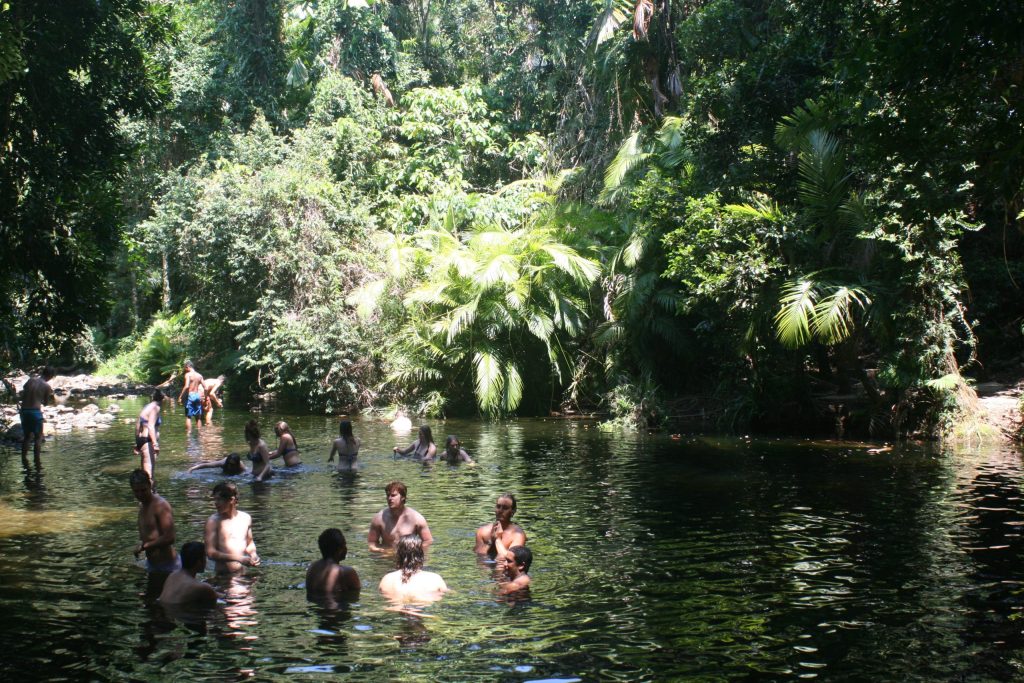
Arrival: Welcome to the tropics! You arrive in Cairns and are warmly greeted by one of our staff members at the airport. (Arrive before 12 noon today).
Presentation on Biodiversity and The Wet Tropics: Before visiting the rainforest, you first learn about the biodiversity of The Wet Tropics, of which the Daintree Rainforest is a part. More than 100 animals are rare or threatened here and dozens of species live nowhere else in the world. Plants that ruled alongside dinosaurs still stand today. You learn about how Traditional Owners managed the rainforest in the past, and how The Wet Tropics is being managed currently at the local, regional and national levels. You learn why this corner of Australia with its jade mountains and lush emerald rainforest is a geographical anomaly. You discuss effects of climate change, vulnerability versus resilience and biophysical interactions within The Wet Tropics. You leave with insight about and appreciation of this globally significant area you are about to visit.
Daintree Rainforest Research Station: Next you travel north and enter the magical Daintree Rainforest – the oldest continuously growing rainforest on earth. By special arrangement with Small World Journeys, you arrive at James Cook University’s Daintree Rainforest Observatory, an eco-monitoring site and research station with wet and dry labs. It lies in the heart of the Daintree Rainforest, and claims the highest biodiversity of anywhere in Australia! You get a safety induction and orientation and then a presentation about the significance of this rainforest. You learn about important research and innovations in sustainable management that are happening here, as well as how invasive species are creating ecological disturbances and how the station is managing this. (Activities at research station only available on week days)
Night Walk in The Daintree: After dinner, you can embark on a rainforest walk under the cover of night—an opportunity to witness the Daintree come alive in a way few ever experience. You can search for crepuscular and nocturnal species, paying close attention to endemic wildlife found nowhere else. The night setting offers a rare glimpse into behaviors and biodiversity hidden during daylight hours, deepening students’ understanding of ecological relationships and the intricate web of life within this ancient rainforest.
Accommodation: Daintree Rainforest Research Station
Meals Included: Lunch, Dinner
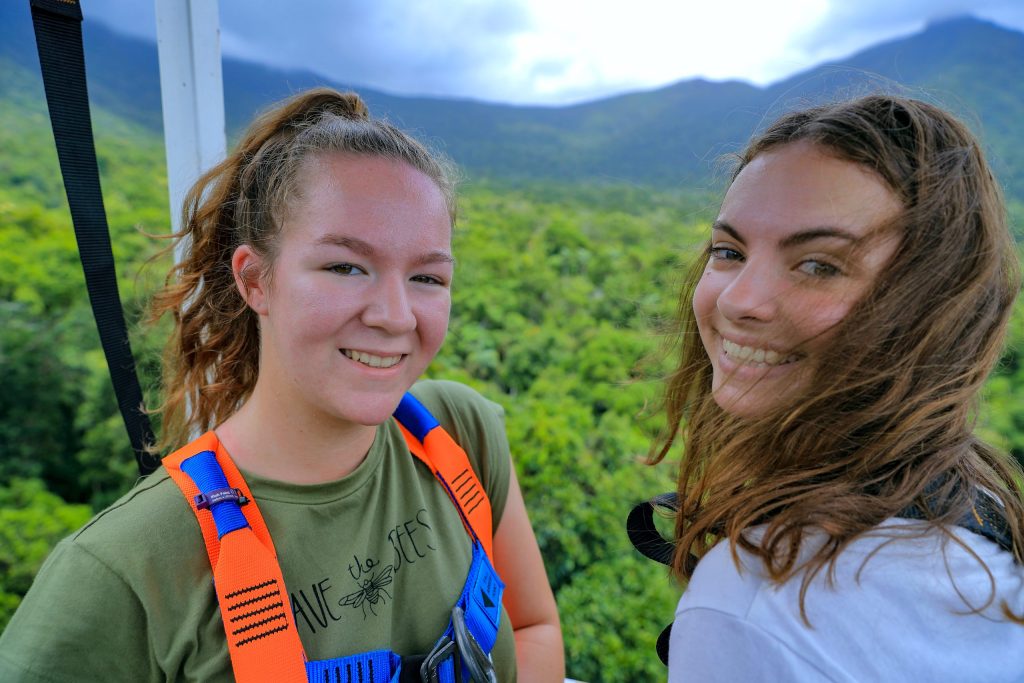
Environmental Debate: This morning you participate in a debate in which each small group takes on a role and presents their argument either for or against a planned development for Cairns. Students must take into account environmental, economic and socio-cultural factor in their arguments, and teachers vote on the most persuasive side. This is a fun way for you to get involved with all sides of an environmental debate with a real-life example that has gained significant media attention.
JCU Canopy Crane: The James Cook University Research Station is home to their canopy crane and Small World Journeys students get special access to it today. After a safety orientation and a discussion about the significance of this rainforest by an on-site expert, you climb into a suspended gondola with the crane operator. The crane then ascends over the rainforest canopy, and can swing 360 degrees, surveying 1 hectare of the incredible biodiversity that has earned the Daintree UNESCO World Heritage status. This research station is only 1 of 3 of its kind existing in the tropics. (Students must be at least 15 years old. Activity runs Monday-Friday only).
Water Quality Measurements & Aquatic Invertebrate Sampling: Whilst not in the crane, you discover the language of water and what it says about the creatures that can survive in it. Today with nets and buckets you take water quality measurements involving indicators like pH, nitrate, dissolved oxygen and phosphate levels from both an on-site pond and a stream. Testing for these elements may reveal the presence of fertilizers or biological extremes, which will also aid in your discussion about species survival rate, influences from environmental conditions and eutrophication. You bring your samples back to the lab to investigate under microscopes and can draw conclusions based on an easy-to-use “SIGNAL” biotic index.
Geography & the Reef Presentation: Later you travel back to Cairns. During a lively presentation taught by a marine naturalist, you learn more about how The Great Barrier Reef evolved and about how natural and human impacts are causing it stress. You also learn how Indigenous people have traditionally managed the reef, and how it’s managed today. Along the way, you also discover what makes the reef vulnerable and what allows it to bounce back from disturbances and stress. Your naturalist prepares you to identify biophysical interactions at the reef, how geomorphology changes the reef and what innovative techniques scientists are using to protect the reef from the effects of climate change.
Accommodation: Cairns 3-star hotel
Meals Included: Breakfast, Lunch, Dinner

Ferry Ride: This morning you are ferried to the pristine Fitzroy Island. A fringing coral reef surrounds the island, part of the inner Great Barrier Reef, providing a sheltered home for a kaleidoscope of marine life: colourful corals, parrot and lionfish, turtles, cuttlefish, rays and giant clams. Your marine biologist gives you some background about signs of a healthy reef, resilience at the reef before reviewing safety and use of your snorkel gear.
Guided Snorkelling: With full use of snorkel gear for the day, you can walk right into the water to explore the magnificent reef system that surrounds the island. Your marine biologist leads you to underwater examples of biodiversity, parasitism, and commensalism as well as examples of the reef’s most interesting features.
Activity Addressing Contemporary & Traditional Protected Area Management: A lunchtime mapping activity also helps students with their geography skills and to understand management strategies for the reef, both present and past. Students are led into a discussion about how the area has been traditionally managed by the Aboriginal and Torres Strait islander people for over 60,000 years, addressing topics such as sustainable fishing, use of totems and Traditional Owner stewardship. Students are encouraged to consider and discuss what challenges there might be in using only traditional management practices today, considering the present day uses of the Great Barrier Reef Marine Park. Contemporary management of the area is also looked at in detail, as well as the zoning plan released in 2003 by the Australian Government.
CoralWatch Data Collection: In the afternoon you collect primary data in an activity that addresses climate change and coral bleaching. During this exercise you find out more about how and why coral bleaches. You learn how to identify different kinds of coral, match its pigments to a waterproof chart, and then record what you observe in teams of two. The data then goes back to the University of Queensland’s Coral Watch scientists, where they analyse the results over time and look for any long term trends.
Turtle Rehabilitation Centre: During your visit you also visit the island’s Turtle Rehabilitation Centre where a collection of volunteers help save sick and injured sea turtles by looking after them until they are ready to be released back into the ocean.
Human Impacts Activity: Students are introduced to an activity that has them evaluating the island’s human impacts throughout the day and are asked to fill in a “report card”.
Accommodation: Cairns 3-star hotel
Meals Included: Breakfast, Lunch, Dinner
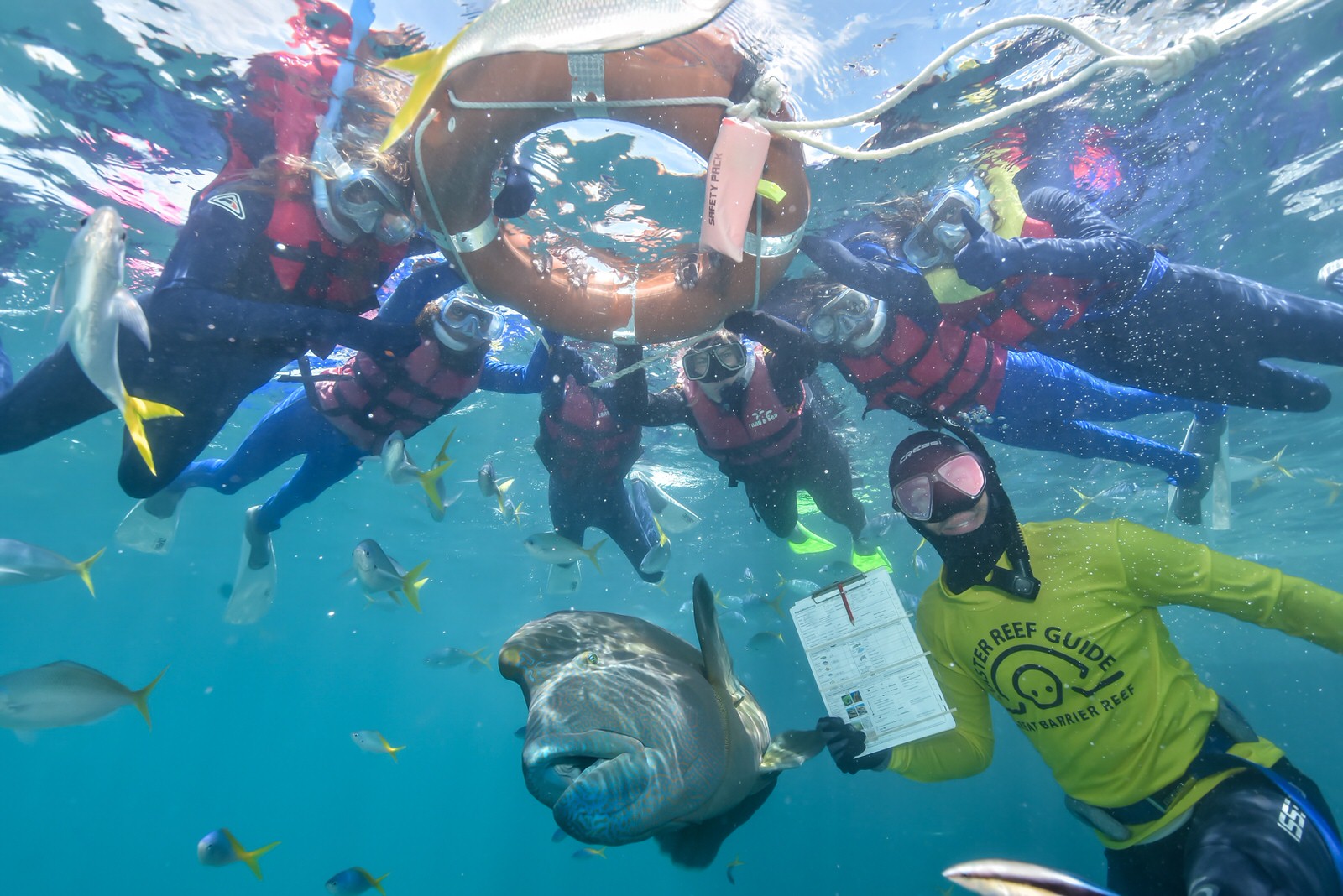
Boat Ride to The Outer Reef & Orientation with Marine Biologist: This morning, you travel aboard an air-conditioned vessel to a floating pontoon located at the outer Great Barrier Reef. Upon arrival, your marine biologist introduces the incredible diversity of reef life they may encounter and provides an overview of the Eye on the Reef program. Through hands-on instruction, you learn how to complete a Rapid Monitoring Survey—an important citizen science initiative that helps track reef health and contributes valuable data to reef management and conservation efforts. By participating, students gain practical insights into ecological monitoring and the role you can play in protecting one of the world’s most important ecosystems.
Citizen Science Data Collection & Species & Predator Identification: Guided by your marine biologist during a timed snorkel session you record your underwater findings. Your guide and waterproof slates help you identify a host of marine life and calculate benthic zone coverage. Most importantly, you look for coral predators which greatly affect the health of the reef. Your data contributes to the central reporting system used by the Great Barrier Reef Marine Park Authority (GBRMPA) to manage the long term sustainability of the Reef.
Pontoon Activities: Back at the pontoon, you are encouraged to continue your reef discovery through immersive experiences including the semi-submarine, glass bottom boat, and underwater observatory. Each activity is designed to enhance your grasp of marine ecosystems and introduce you to the diverse species living beneath the surface. Guided by a marine biologist, you explore how these tiny organisms help forecast outbreaks of Crown-of-Thorns starfish (COTS)—a species linked to climate change impacts that can severely damage coral reefs. Students also learn about Crown-of-Thorns starfish (COTS): current research taking place by scientists and organisations tackling reef-related climate challenges, and how this modern ecosystem management is done through monitoring and targeted intervention. Finally, you are introduced to a reef restoration initiative—an example of human-induced environmental modification—that repairs cyclone-damaged coral areas which, without such efforts, remain as rubble.
Field Guide: 101 Animals of The Great Barrier Reef, written by Dr. Martin Cohen, helps you to better understand the underwater world and is yours to keep.
Back in Cairns, you have a free choice dinner in town tonight with an optional visit to the Night Markets.
Accommodation: Cairns 3-star hotel
Meals Included: Breakfast, Lunch
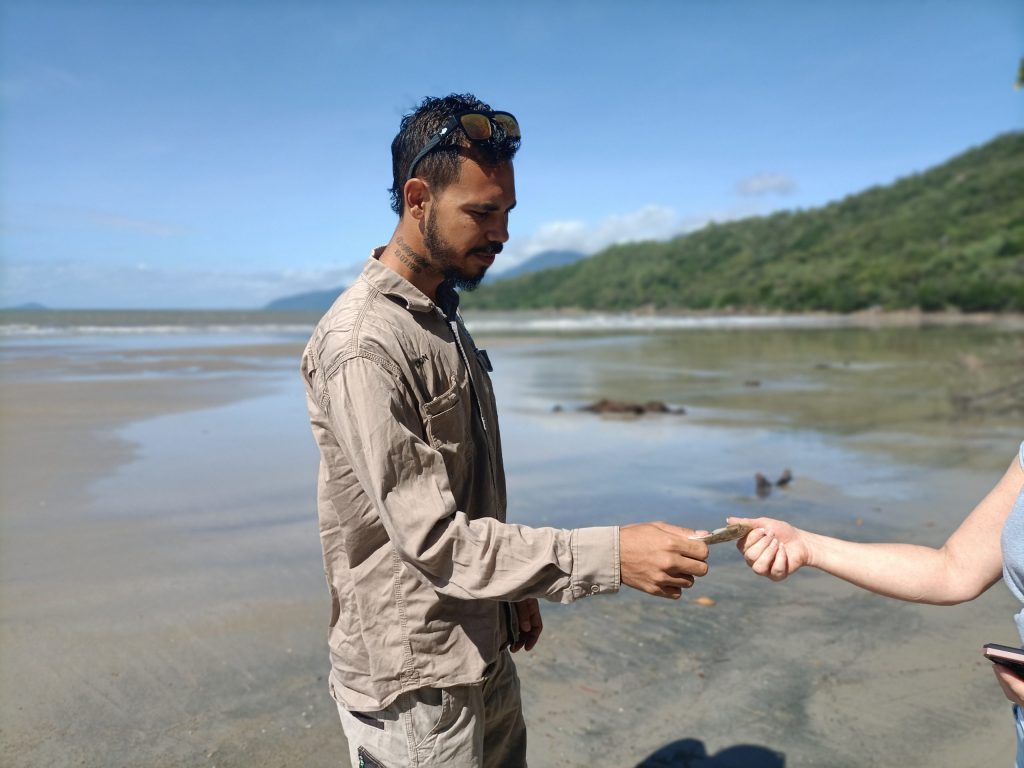
On Country Cultural Experience with Indigenous Rangers: Your trip to Far North QLD begins with an exclusive experience on country, you head south from Cairns to an Indigenous community; traditional country of the Gunggandji and Yidinji people. After a welcome to country smoking ceremony Gunggandji-Mandingalbay Yidinji Rangers share stories about the history of the community and life in community. Students are led into discussion of the importance of the Ranger Program and managing country and how land and sea rangers play an important role in their local communities. Rangers work closely with their Elders to plan caring for country as well as their community contribution through modelling leadership, cultural connection, and assisting with inter-generational knowledge sharing. Other topics include the types of activities Rangers are undertaking, in particular how drones are used by Gunggandji-Mandingalbay Yidinji Rangers to monitor crocodiles. A spear making and throwing demonstration will educate students of the different types of spears, how they are traditionally made, and how to throw a spear. (allow 6.5 hours total for travel to and from location and activities).
Airport Transfer and Depart: Eventually all good things must come to an end, you travel back to Cairns with your guide and to the airport for your departure flight. (Plan to depart no earlier than 4 pm)
Meals Included: Breakfast, Lunch
How Your Trip Makes The World A Better Place
We’re not talking rainbows and unicorns. We’re talking about how we have put significant thought into how to make our student tours as safe as they possibly can be while still being fun; encouraging students to learn about and contribute to the community they are travelling in; and teaching them what “sustainability” really means.

Sustainability
OUR COMMITMENT: We are determined and motivated to be the most sustainable business we can be. This is why we run our office on renewable energy, voluntarily offset our carbon emissions (AND your flights to get to us!), and fulfilling our policy to give at least 5% of our annual net profits to local environmental and community organisations and charities. Here’s what else we are doing:
HELPING THE REEF: For every group that visits the reef, we make a donation to the Reef Restoration Foundation (RRF) to support their "Care for a Coral" program. The coral propagation work led by RRF is groundbreaking and recognised as a major initiative in efforts to help restore the reef. Each group receives a "Care for a Coral" certificate from RRF as a token of our contribution and commitment to reef conservation.
ADOPTING A RAINFOREST PLOT IN YOUR NAME: For each group that visits the rainforest, we contribute to the not-for-profit organisation Reforest to support the planting and nurturing of a tree, helping to regenerate the endangered Mabi rainforest. As part of your excursion, your group will receive a certificate recognising this meaningful gift to the environment.
CREATIVE WASTE REDUCTION: We give you your own water bottle and cloth shopping bag to eliminate the need for disposable bottles and plastic bags (and saves them from going in landfills!) We also recycle BOTH our hard plastics and soft plastics (through RedCycle) and have transitioned into NO WASTE snacks and NO WASTE lunches. Our food scraps get composted and put into our community garden, our bin liners are paper (not plastic) and we even wipe our bums with Who Gives a Crap 100% recycled toilet paper!
[/bg_collapse]
Community
SUPPORTING OUR INDIGENOUS COMMUNITY: It is our policy to include a talk or an activity with an Aboriginal person on every trip we offer. By taking this trip, you are supporting grassroots Indigenous tourism ventures and encouraging Aboriginal pride in culture. Additionally, our student community service project involves students in making “Moon Sick Care Bags” which supply re-usable sanitary products to Aboriginal women in remote communities — this helps both Indigenous women AND the environment! (Ask us how your group can do this on their tour)
SUPPORTING LOCAL BUSINESSES: It is our policy to use locally owned suppliers and businesses unless their standards are not up to par (for example, if they have a bad environmental record).
VOLUNTEERING IN OUR COMMUNITY: Small World staff are incentivised to volunteer in the community...

Safety
SUPERB SAFETY RECORD: We’ve had thousands of students travel with us, and our safety record is excellent. Ask us for teacher references specifically regarding safety.
RISK ASSESSMENT FOR EVERY TRIP: We do a risk assessment for every student tour we run, and is sent to your organising teacher. We have safety protocols for our activities and a Standard Operating Procedure (SOP) Manual that documents these protocols. We also have a complete Crisis Management Plan. In addition:
SAFE BUSES: All of our buses are equipped with seatbelts for every seat. While this is not a Queensland law to have them, we feel your safety is a priority. Our guides do safety checks at the start of each day of the trip. In addition, vehicles go through a Department of Transport safety inspection every 12 months...
We do custom trips!
Still haven’t found exactly what you are looking for? All our tours are fully customisable and can be catered to suit your time-frame, student interests and budget. A geography excursion to the Great Barrier Reef? A biology excursion to the Daintree Rainforest? An Aboriginal culture excursion? Our educational trips in Queensland and New South Wales are hand-crafted for those who cannot find exactly what they want from the inflexible set itineraries of large tour operators.
If you are looking for a science trip, ecology trip, Aboriginal culture, or just a sample of the best of Australia – we can help.




